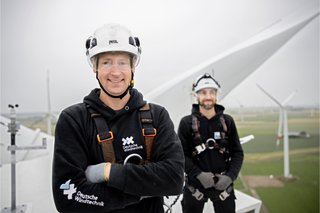“The jacks are used in the installation phase to bring the transition pieces into position and stabilise them. Even though the situation seemed to be stable as the conical connection still had an adequate axial capacity, the jacks needed to be removed as soon as possible to prevent any fatigue damage initiated over time,” said Wen-Lai Tien, Chief Engineer, Deutsche Windtechnik Co. Ltd., explaining the underlying issue.
Deutsche Windtechnik accepted the challenge
Following a number of unsuccessful attempts by other service providers, the operator turned to Deutsche Windtechnik to rectify the fault. A project team comprising ten Deutsche Windtechnik employees from the Engineering, Technical Support, Service, HSE and Project Management departments ran various scenarios for the necessary removal of the jacks. Among other approaches, the group led by Chief Engineer Wen-Lai Tien set up a jack with an identical construction, positioned it in a comparable situation and simulated the process of removing the jack from the transition piece “in dry conditions”. The results of this model test were positively received, and they were thoroughly evaluated in collaboration with the responsible operators' team representatives. Subsequently, a well-defined procedure for the actual removal of the jacks was established.
Process monitoring by means of ongoing tests
In order to ensure the stability of the wind turbine, vertical measurements of the respective wind turbine were performed regularly both before and after removal of the jacks. These revealed that the deflection was minimal and laid by far within the acceptable tolerances after the work was completed, thus confirming the service deployment’s success.
Excellent cooperation saw project completed ahead of schedule
The fact that Deutsche Windtechnik was able to offer the operator of the wind farm a solution is a credit to the goal-oriented cooperation between the partners. Many employees from different departments at both companies contributed to the success of the project with their sound technical expertise and transparent communication. “We had originally scheduled 20 days for the confined space work. After the contract signing, we received feedback from the Employer’s Consultant to include additional steps as safety measurement, which increased the schedule from 20 days to 32 days. Regardless of the extremely challenging situation from both, a planning and a physical perspective, the project team continued to put forth their best effort. Furthermore, even though our offer was based on a day rate, the entire Deutsche Windtechnik team strived for excellence and successfully completed the task a week earlier than the original schedule.” said Sheau-Chin Lim, Senior Project Manager, Deutsche Windtechnik proudly.




